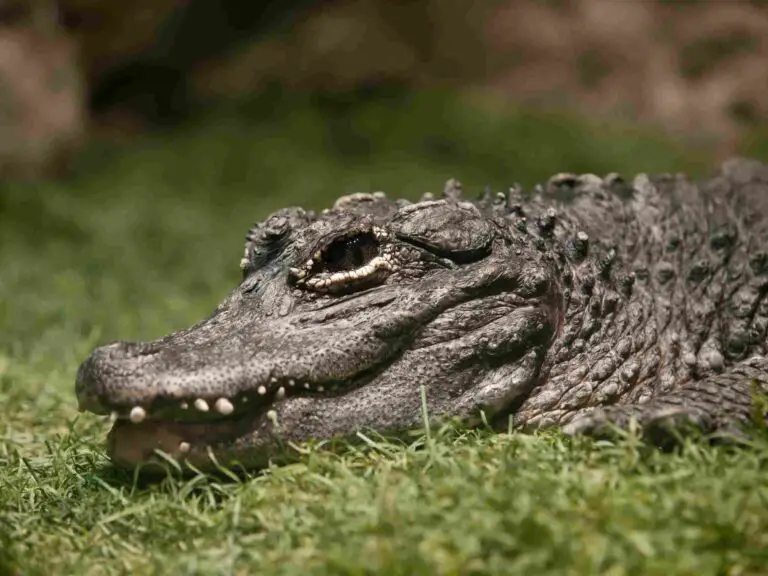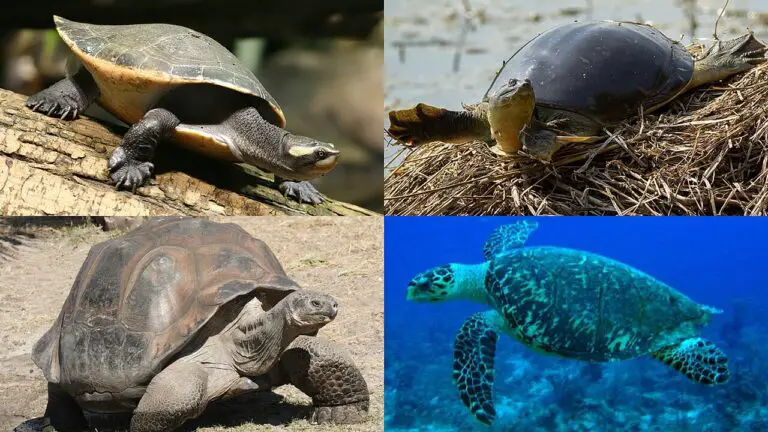Chimpanzee Vs Orangutan Who Would Win, Overall Comparison
Diving into the world of great apes, the comparison between chimpanzees and orangutans unveils distinctive features, highlighting differences in intelligence, strength, and hypothetical combat scenarios.
I. Cognitive Capabilities:
– Orangutans stand out for their remarkable cognitive abilities, displaying an understanding of specific actions. Studies suggest that orangutans may excel in tasks, showcasing a unique facet of intelligence. While chimpanzees are known for their problem-solving skills, the cognitive prowess of orangutans is noteworthy.
II. Size and Strength:
– Orangutans, with their solitary lifestyle, tend to be larger and stronger than chimpanzees. Their impressive physical strength, coupled with their size advantage, sets them apart. In contrast, chimpanzees, although smaller, are known for their agility and social behaviors.
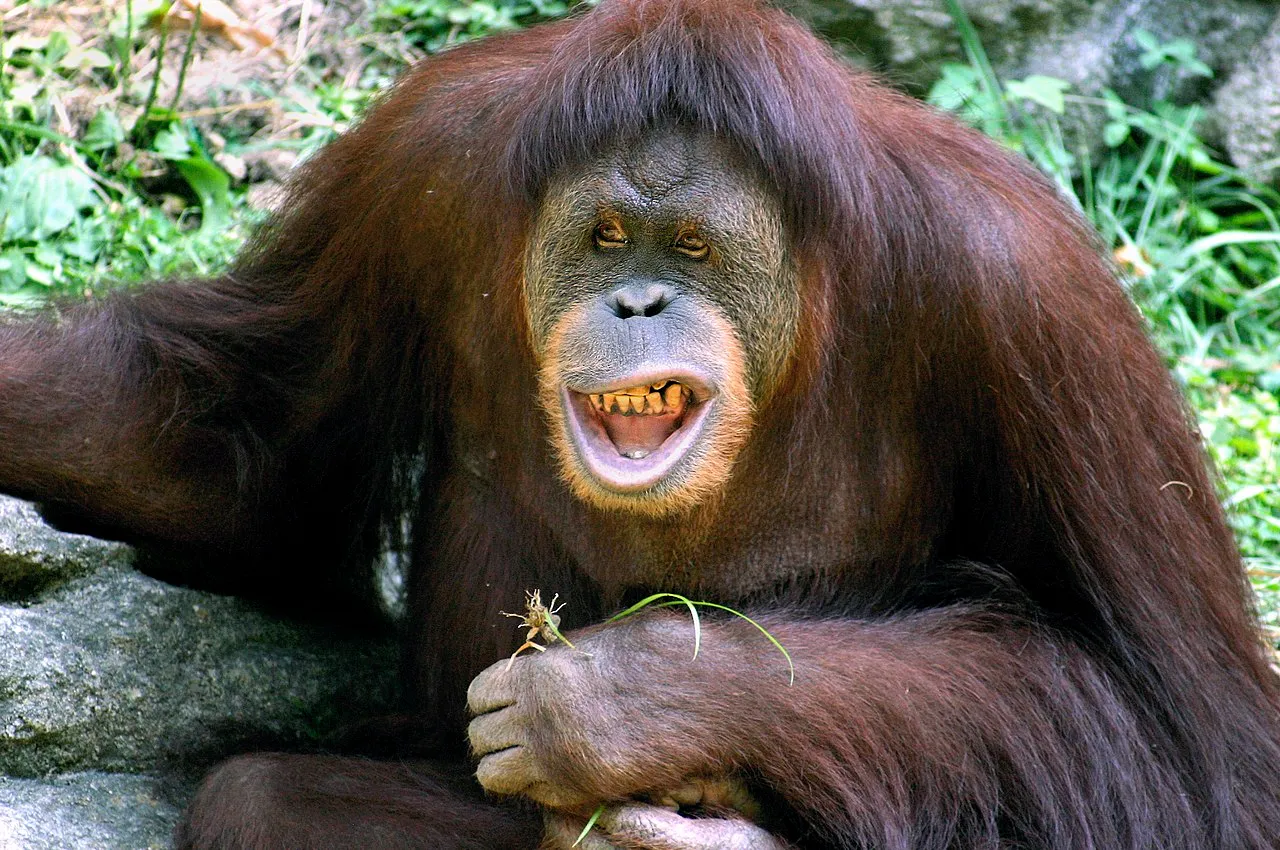
III. Fight Prediction:
– In a combat scenario, the outcome between an orangutan and a chimpanzee may be influenced by factors such as size, strength, and individual temperament. While male orangutans are notably larger and stronger, chimpanzees are known for their agility and group coordination. The victor would depend on various situational dynamics.
However, on average, the orangutan would win a fight against a chimpanzee using it’s size and strength advantage.
IV. Social Behavior:
– Chimpanzees exhibit complex social structures, living in groups of up to 20 individuals. In contrast, orangutans are solitary creatures. The difference in social behaviors contributes to the unique lifestyles of these great apes.
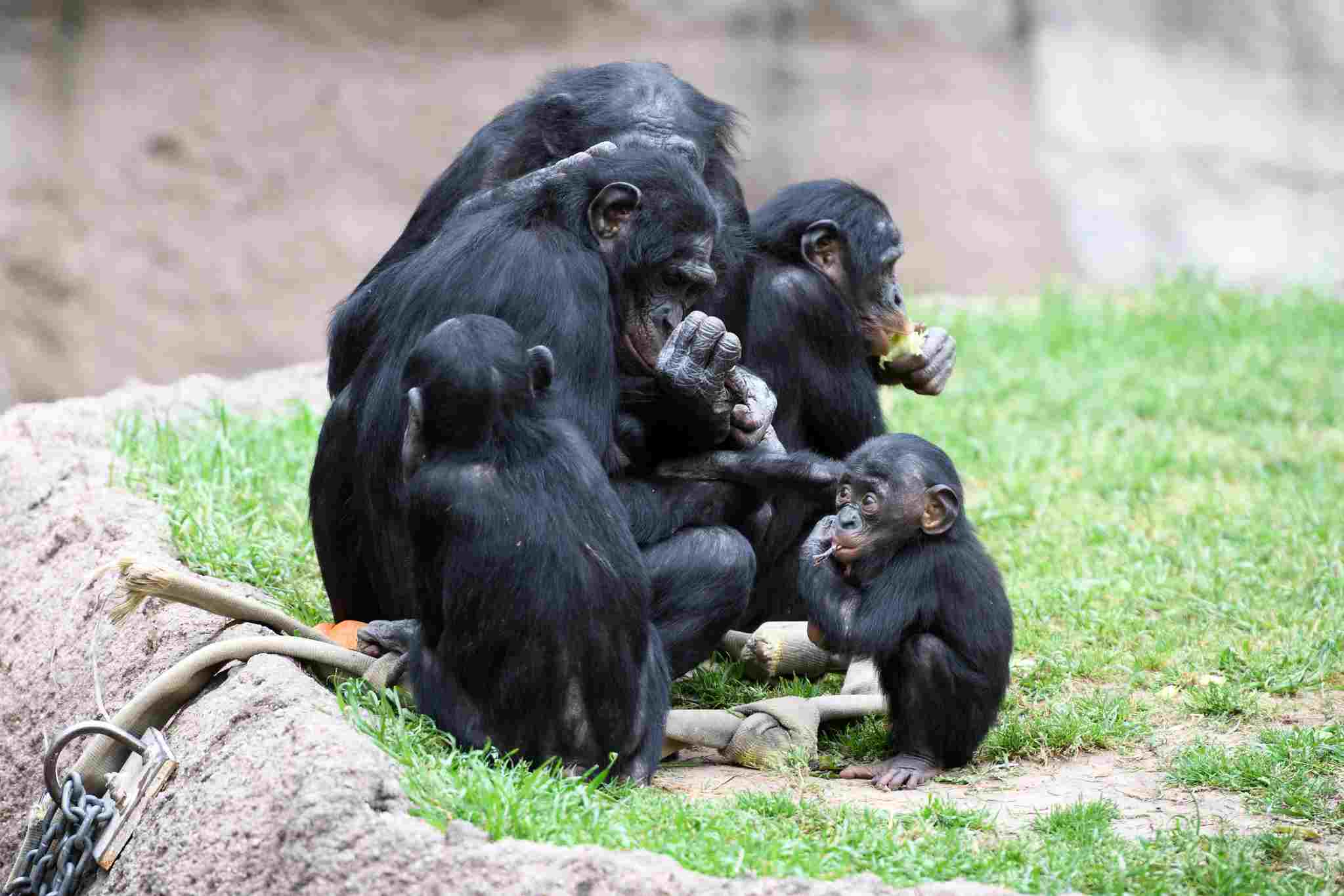
V. Scientific Perspectives:
– Scientific research, such as genomic studies, contributes to understanding the phylogenetic relationships among humans, chimpanzees, gorillas, and orangutans. The evolutionary connections among these species shed light on the complex web of genetic heritage.
*Details of Comparison
| Criteria | Chimpanzee | Orangutan |
| Appearance | Robust build, black to brown fur, prominent ears, no tail |
Shaggy reddish-brown hair, large body, pronounced cheek pads in males
|
| Size | Males 90-130 cm, Females 70-100 cm |
Males 120-180 cm, Females 100-130 cm
|
| Weight | Males 40-60 kg, Females 27-50 kg |
Males 50-120 kg, Females 30-50 kg
|
| Dentition and Bite Force | Robust teeth, 1,000 psi bite force |
Long canines, 1,300 psi bite force
|
| Offensive Advantages | Cooperative attacks, tool use |
Intimidating presence, skilled climbers
|
| Defensive Advantages | Group defense, agile climbing |
Climbing skills, dominant males’ physical prowess
|
| Speed | Around 40 km/h |
Not adapted for fast terrestrial locomotion
|
| Agility | Agile in trees and on the ground |
Arboreal agility, less agile on the ground
|
| Senses | Vision for depth perception, excellent hearing |
Reliant on acute vision, vocalizations for communication
|
| Physical Capacity | Agile, strong arms, tool use |
Powerful climbers, long arms, solitary nature
|
| Habitat Preference | Various habitats in Central and West Africa |
Primarily tropical rainforests in Borneo and Sumatra
|
| Tracks | Opposable thumbs, knuckle-walking tracks |
Long fingers and toes, heel-first walking pattern
|
| Lifespan | 40-50 years |
Bornean 35-45 years, Sumatran 30-40 years
|
| Mode of Feeding | Omnivores with diverse diet |
Primarily frugivores, fruits as a significant part
|
| Intelligence | Highly intelligent, tool use, complex social structures |
Intelligent, problem-solving, individualistic cognitive adaptations
|
| Social Behavior | Large, complex communities, strong social bonds |
Generally solitary, limited social interactions
|
| Reproduction | Polygamous mating, shorter inter-birth interval |
Solitary mating, longer inter-birth interval
|
| Parental Behavior | Offspring stay, maternal care involves grooming |
Prolonged maternal care, limited social interaction
|
| Proximity to Humans | Face threats from habitat loss, illegal activities, and human-wildlife conflicts |
Face threats from habitat loss, illegal activities, and human-wildlife conflicts
|
| Behavior Toward Humans | Varied responses, potential aggression |
Generally shy, avoidant of humans
|
| Danger Posed to Humans | Can be aggressive if threatened |
Generally pose minimal danger, shy and avoidant
|
| Associated Precautions | Caution in overlapping habitats, guidelines for minimizing conflicts |
Awareness programs, conservation measures for habitat protection
|
| Conservation Status | Varies by subspecies, endangered or vulnerable |
Bornean endangered, Sumatran critically endangered
|
Key Points
Similarities:
-
- Face threats from habitat loss, human-wildlife conflicts, and illegal activities.
Differences:
-
- Social structures, ecological roles, and conservation statuses vary.
- Chimpanzees are more social, while orangutans are more solitary.
- Orangutans generally have a more critical conservation status.
- Differences in size, weight, dentition, and offensive/defensive advantages.
1. Taxonomy:
Chimpanzee (Pan troglodytes):
Kingdom: Animalia
Phylum: Chordata
Class: Mammalia
Order: Primates
Family: Hominidae
Genus: Pan
Species: troglodytes
Orangutan (Pongo):
Kingdom: Animalia
Phylum: Chordata
Class: Mammalia
Order: Primates
Family: Hominidae
Genus: Pongo
Species: pygmaeus (Bornean) or abelii (Sumatran)
2. Appearance:
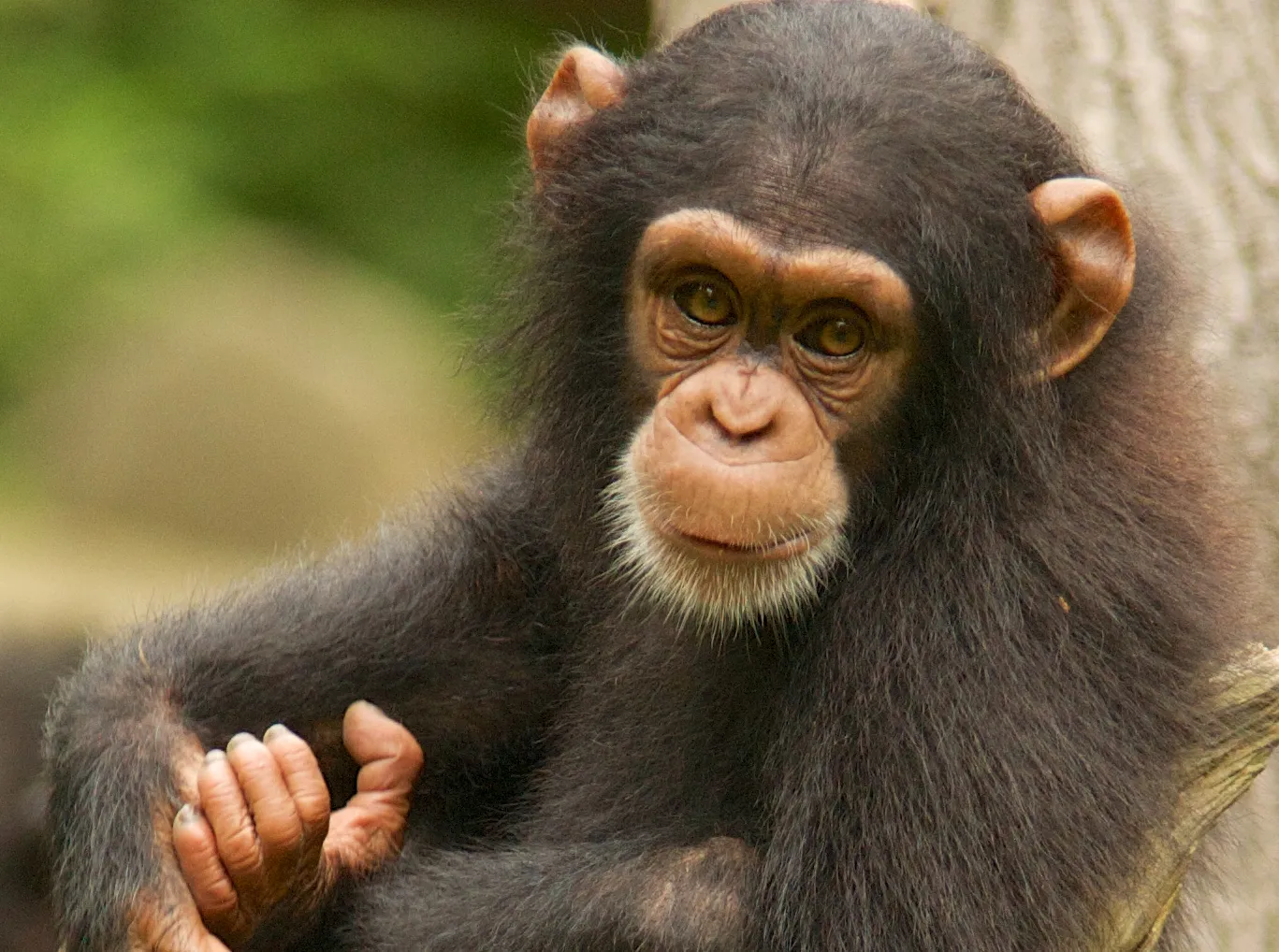
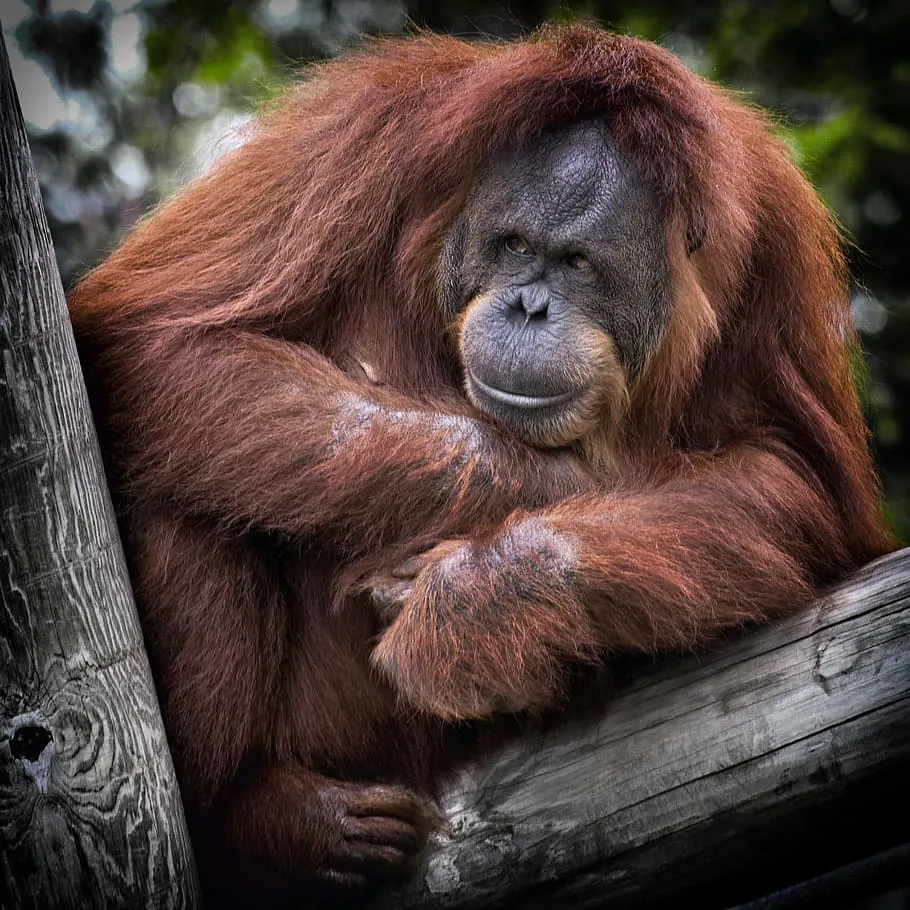
Chimpanzee:
Robust build with long arms and short legs.
Fur color varies from black to brown, lighter on the face.
Prominent ears and no tail.
Orangutan:
Long, shaggy reddish-brown hair.
Large body, heavy with a bulky appearance.
Distinctive facial features including pronounced cheek pads in males.
Comparison:
Chimpanzees exhibit a more slender and agile physique compared to the heavier and more solitary orangutans.
Ecological Implications:
Physical adaptations in appearance reflect their respective habitats and lifestyles; chimpanzees are adapted for a more terrestrial life, while orangutans are arboreal.
3. Size:
Chimpanzee:
Adult males: 90 to 130 cm (3 to 4 ft)
Adult females: 70 to 100 cm (2.3 to 3.3 ft)
Orangutan:
Bornean orangutans are larger than Sumatran orangutans.
Adult males: 120 to 180 cm (3.9 to 5.9 ft)
Adult females: 100 to 130 cm (3.3 to 4.3 ft)
Comparison:
Orangutans are generally larger, especially the males, adapting to their different ecological roles.
Ecological Implications:
Size differences reflect their adaptation to different environments and resource availability, with orangutans requiring more substantial body sizes for arboreal life.
4. Weight:
Chimpanzee:
Adult males: 40 to 60 kg (88 to 132 lb)
Adult females: 27 to 50 kg (60 to 110 lb)
Orangutan:
Adult males: 50 to 120 kg (110 to 264 lb)
Adult females: 30 to 50 kg (66 to 110 lb)
Comparison:
Orangutans are generally heavier, with males significantly surpassing chimpanzee weights.
Ecological Implications:
Weight differences align with their lifestyles; the heavier orangutans are adapted for an arboreal existence, while chimpanzees’ weight suits their more terrestrial behavior.
5. Dentition and Bite Force (PSI):


Chimpanzee:
Robust teeth with pronounced canines.
Bite Force: Approximately 1,000 psi.
Orangutan:
Long canines, especially in males.
Bite Force: Estimated around 1,300 psi.
Comparison:
Orangutans generally have a stronger bite force, especially due to their large canines.
Ecological Implications:
Differences in dentition and bite force correlate with their respective diets and social structures, influencing feeding strategies and interactions within their ecosystems.
6. Physical Offensive Advantages:
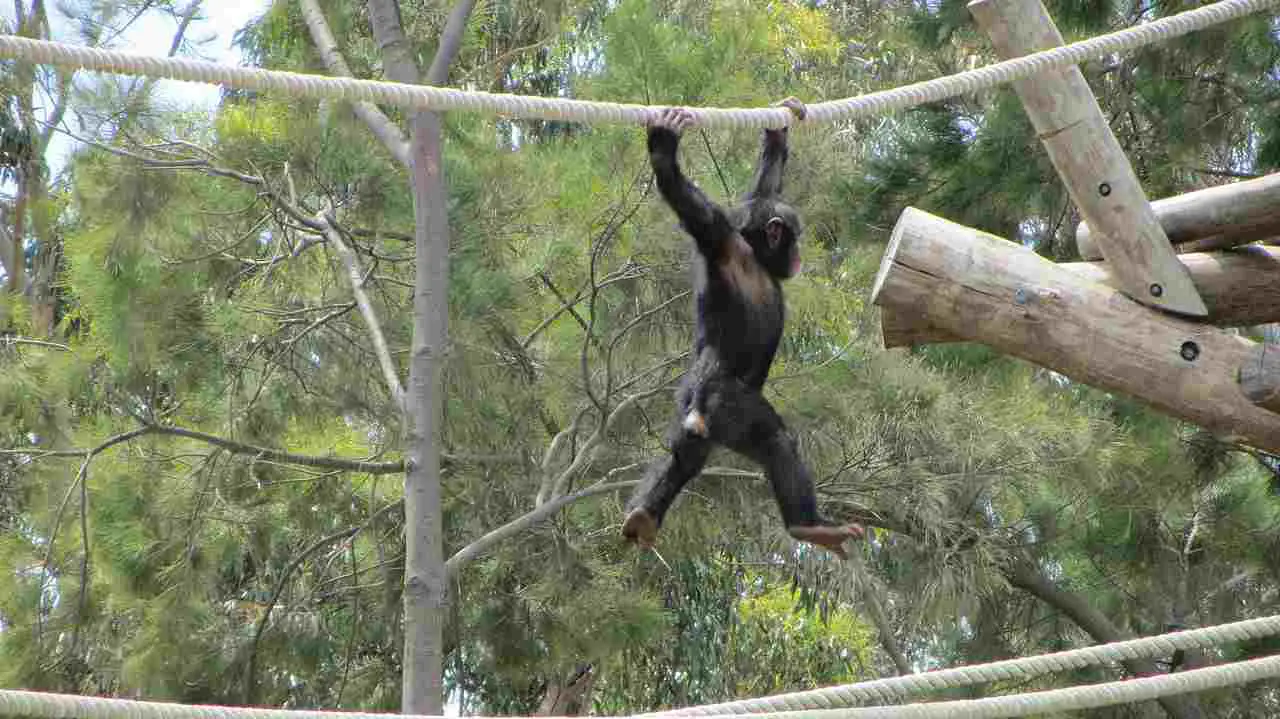
Chimpanzee:
Strong social structure enables coordinated attacks.
Powerful arms and hands for efficient tool use, enhancing offensive capabilities.
Orangutan:
Dominant males possess large body size and long canines for intimidation.
Skilled climbers, allowing them to navigate and strategize from trees.
Comparison:
Chimpanzees rely on social cooperation and tool usage, while orangutans use their intimidating presence and arboreal agility for defense.
Ecological Implications:
Offensive advantages are adapted to their respective environments, reflecting social structures and resource availability.
7. Physical Defensive Advantages:
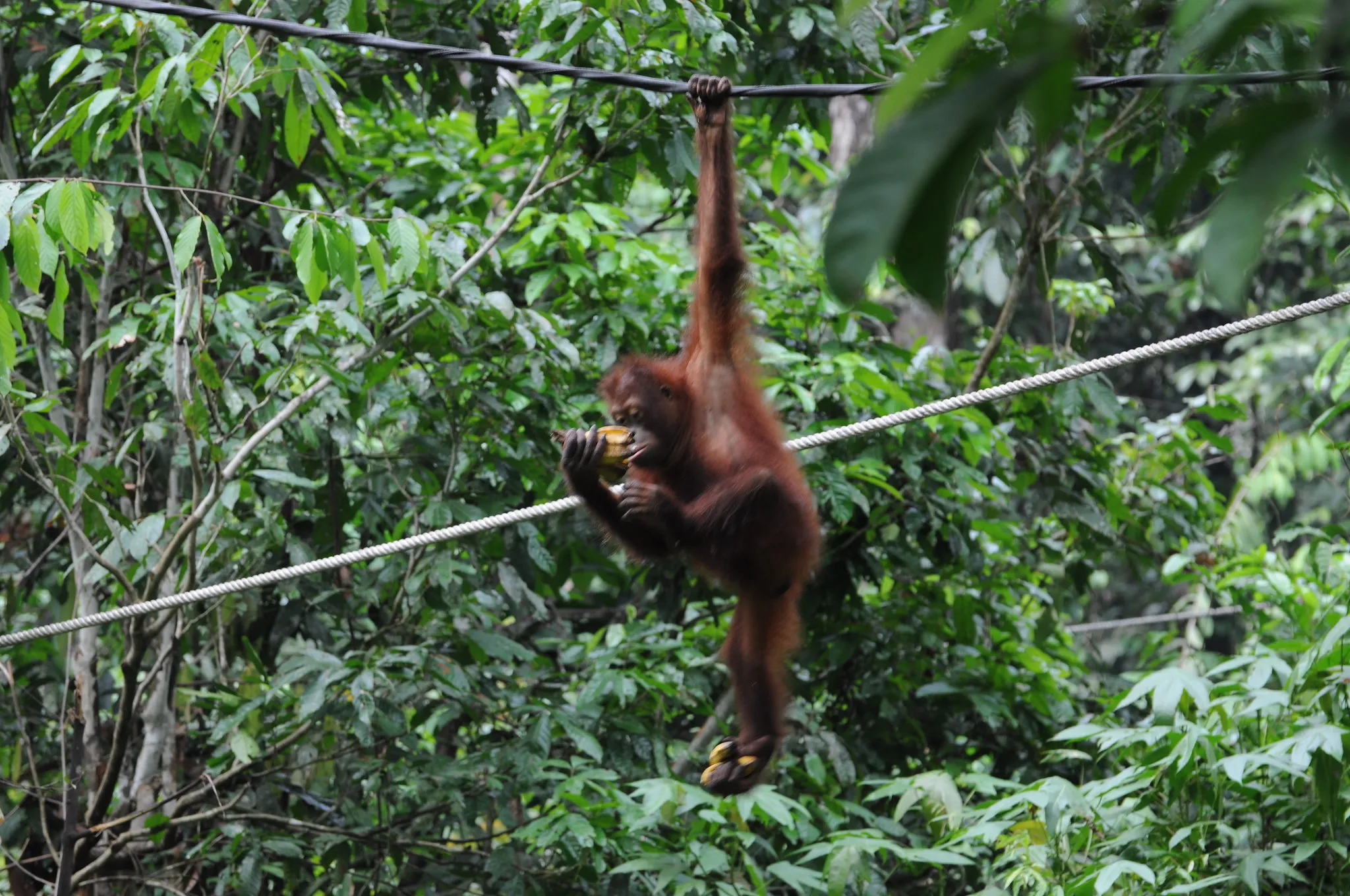
Chimpanzee:
Group defense with strong social bonds.
Agile and capable of escaping threats by climbing trees.
Orangutan:
Climbing skills for quick escape from ground predators.
Dominant males display physical prowess to deter potential threats.
Comparison:
Both species employ climbing as a defensive strategy, but chimpanzees rely more on group cooperation, while orangutans emphasize individual prowess.
Ecological Implications:
Defensive strategies are shaped by their ecological niches, emphasizing the importance of social bonds for chimpanzees and individual strength for orangutans.
8. Speed (Km/hour or Mile/hour):
Chimpanzee:
Agile and quick on the ground, estimated speed around 40 km/h (25 mph).
Orangutan:
Not adapted for fast terrestrial locomotion; slower on the ground.
Comparison:
Chimpanzees demonstrate greater speed and agility in their terrestrial movements compared to the more arboreal orangutans.
Ecological Implications:
Speed differences align with their habitats; chimpanzees’ ground agility suits their savanna and forest-edge environments, while orangutans’ slower pace reflects their arboreal lifestyle.
9. Agility:
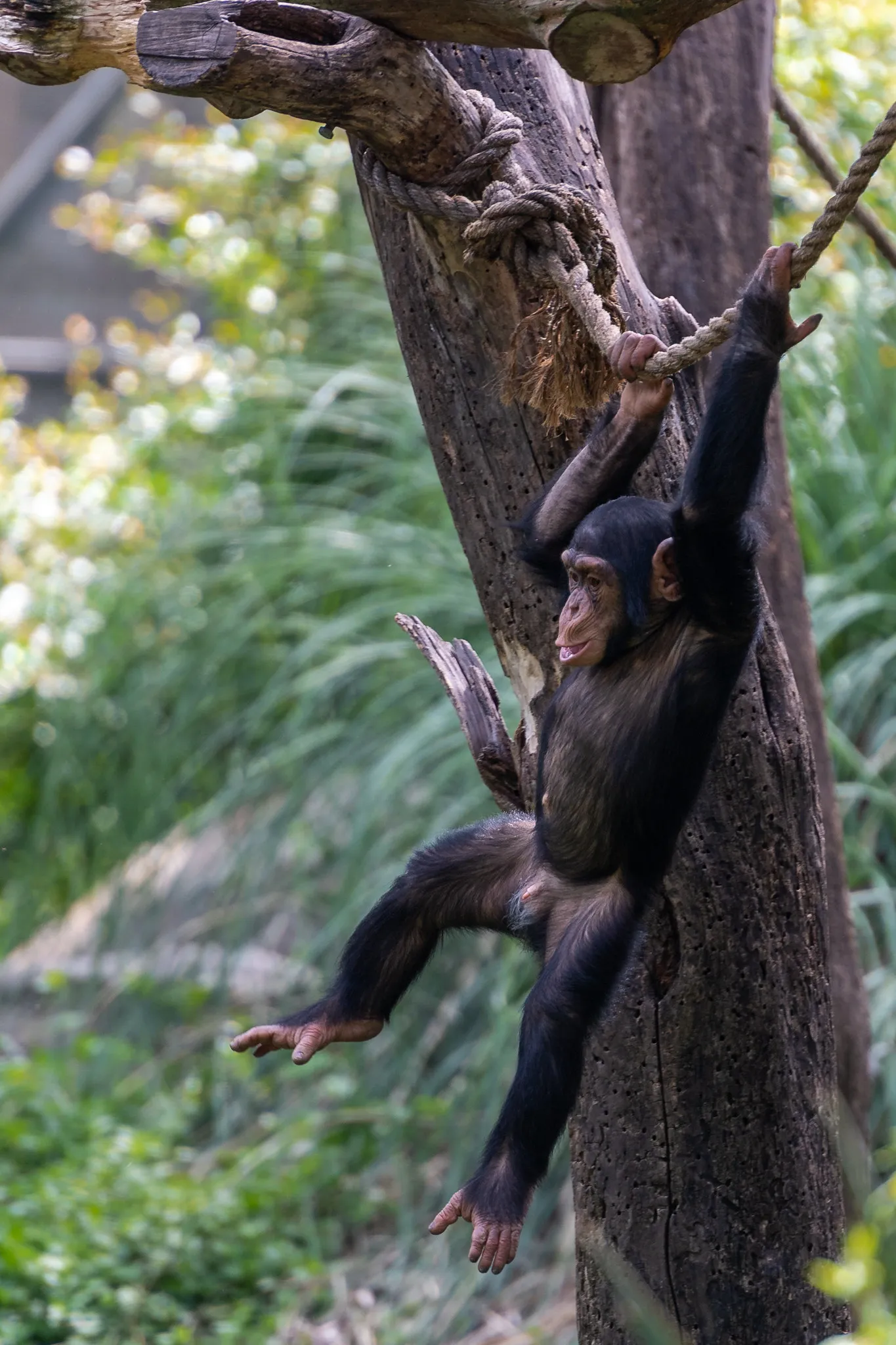
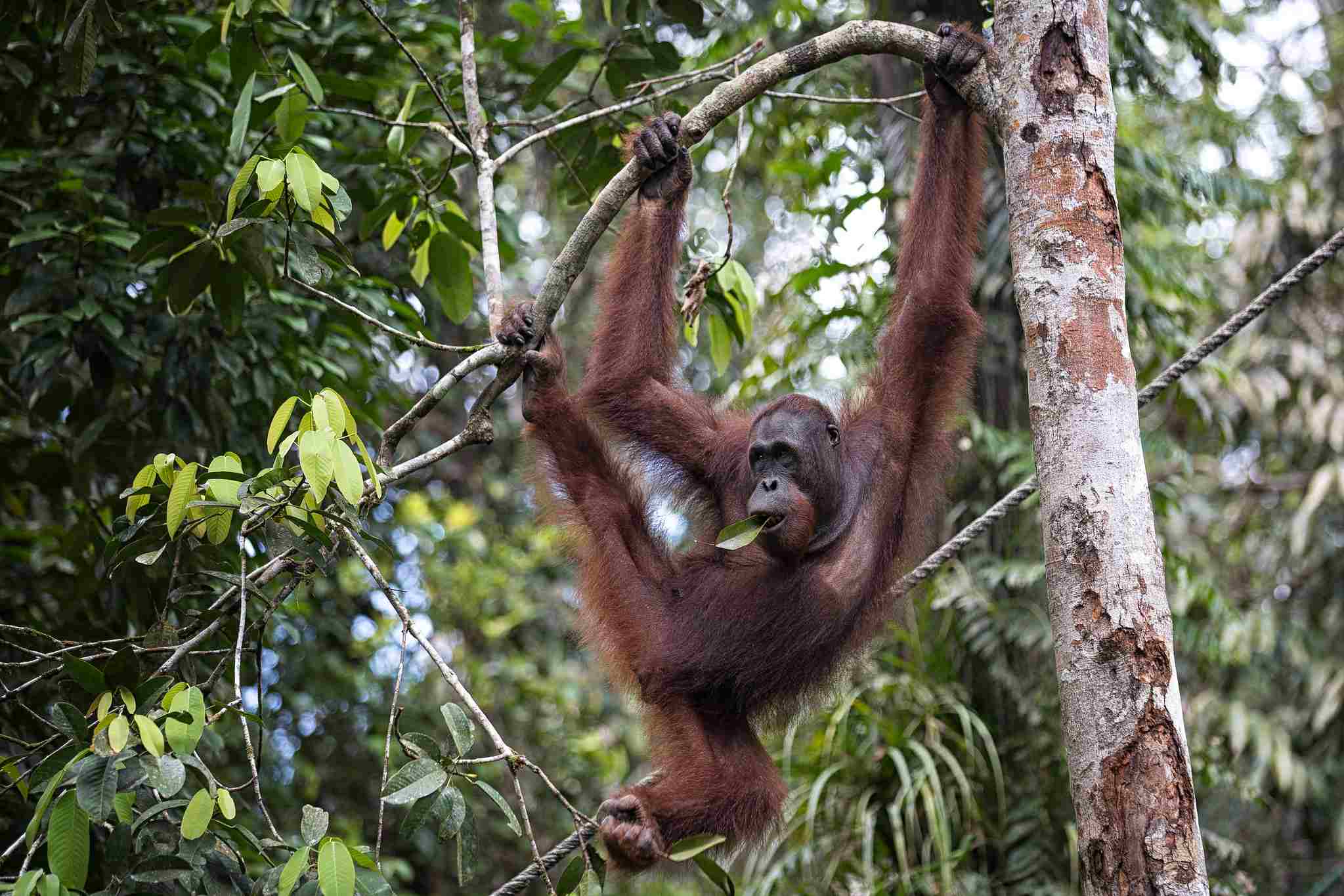
Chimpanzee:
Exceptional agility in trees and on the ground.
Well-adapted for swinging and climbing.
Orangutan:
Arboreal agility with strong climbing and swinging abilities.
Less agile on the ground compared to chimpanzees.
Comparison:
Both species exhibit impressive agility, but chimpanzees excel in ground movement, while orangutans are specialized for arboreal activities.
Ecological Implications:
Agility differences reflect their reliance on different niches within their ecosystems, showcasing adaptations to their specific habitats.
10. Senses:
Chimpanzee:
Well-developed vision for depth perception.
Excellent hearing and communication through vocalizations and body language.
Orangutan:
Reliant on acute vision for navigation in the forest.
Vocalizations, including long calls, play a crucial role in communication.
Comparison:
Both species possess keen senses, but chimpanzees rely more on communication through vocalizations, while orangutans emphasize visual acuity in their forested habitats.
Ecological Implications:
Senses are adapted to their specific environmental challenges, such as navigating through dense forests or coordinating social interactions.
11. Overall Physical Capacity:
Chimpanzee:
Agile, with strong arms and hands for tool use.
Well-coordinated in group activities and hunting.
Orangutan:
Powerful climbers, using long arms and strong fingers.
Solitary nature with a more deliberate pace in movement.
Comparison:
Chimpanzees showcase high physical capacity through agility and tool use, whereas orangutans excel in climbing and navigating their arboreal environment.
Ecological Implications:
Physical capacities align with their ecological roles, emphasizing either group cooperation or individual resilience.
12. Habitat Preference(s) and Geographic Region:
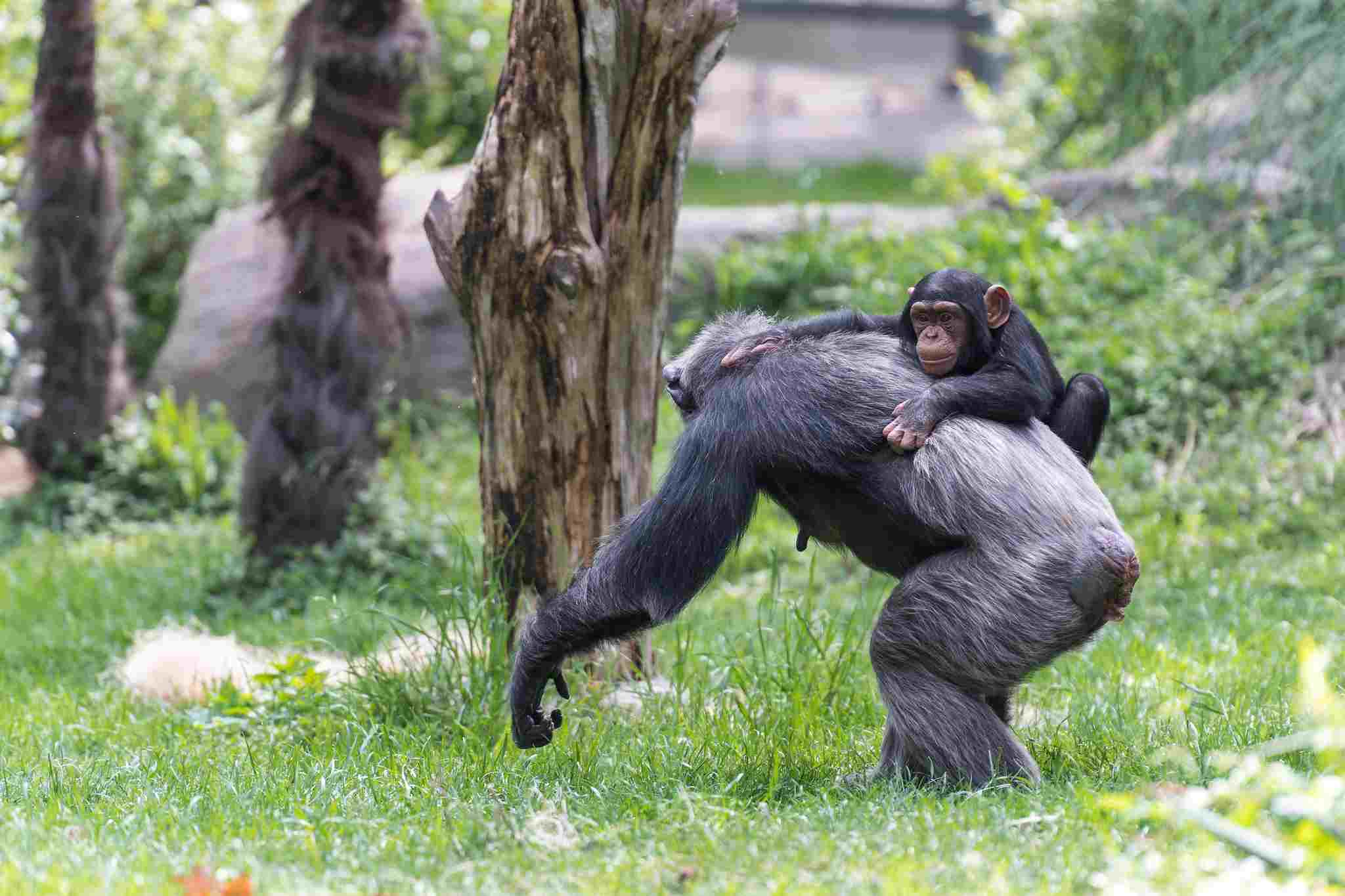
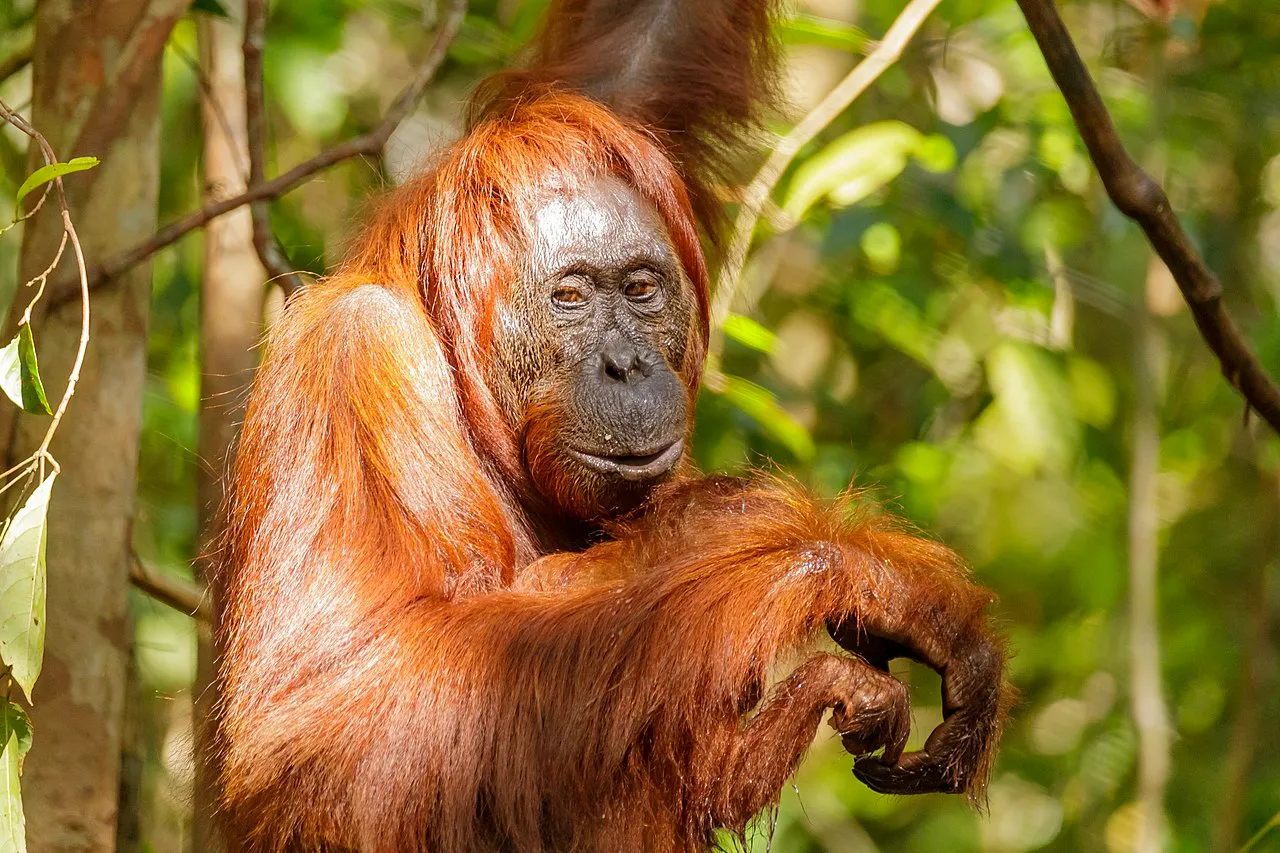
Chimpanzee:
Variety of habitats, including rainforests, savannas, and woodlands.
Found in Central and West Africa.
Orangutan:
Primary habitat in tropical rainforests.
Bornean orangutans in Borneo and Sumatran orangutans in Sumatra.
Comparison:
While both species inhabit tropical regions, chimpanzees have a broader habitat range, including more diverse ecosystems than the more strictly forest-dependent orangutans.
Ecological Implications:
Habitat preferences reflect adaptations to specific ecological conditions, influencing their behaviors and resource utilization.
13. Tracks:
Chimpanzee:
Handprints and footprints show opposable thumbs and a unique pattern.
Display distinctive knuckle-walking tracks when on the ground.
Orangutan:
Handprints and footprints indicate long fingers and toes.
Rarely on the ground, and when they do, exhibit a heel-first walking pattern.
Comparison:
Tracks reflect their different locomotion styles; chimpanzees leave knuckle-walking imprints, while orangutans show heel-first walking patterns.
Ecological Implications:
Tracks provide insights into their terrestrial movements and contribute to understanding their presence in various habitats.
14. Lifespan:
Chimpanzee:
Typically 40 to 50 years in the wild.
Can be extended in captivity.
Orangutan:
Bornean orangutans: around 35 to 45 years.
Sumatran orangutans: around 30 to 40 years.
Comparison:
Chimpanzees generally have a longer lifespan, both in the wild and in captivity, compared to orangutans.
Ecological Implications:
Differences in lifespan may influence reproductive strategies and social structures, impacting population dynamics in their respective habitats.
15. Mode of Feeding:
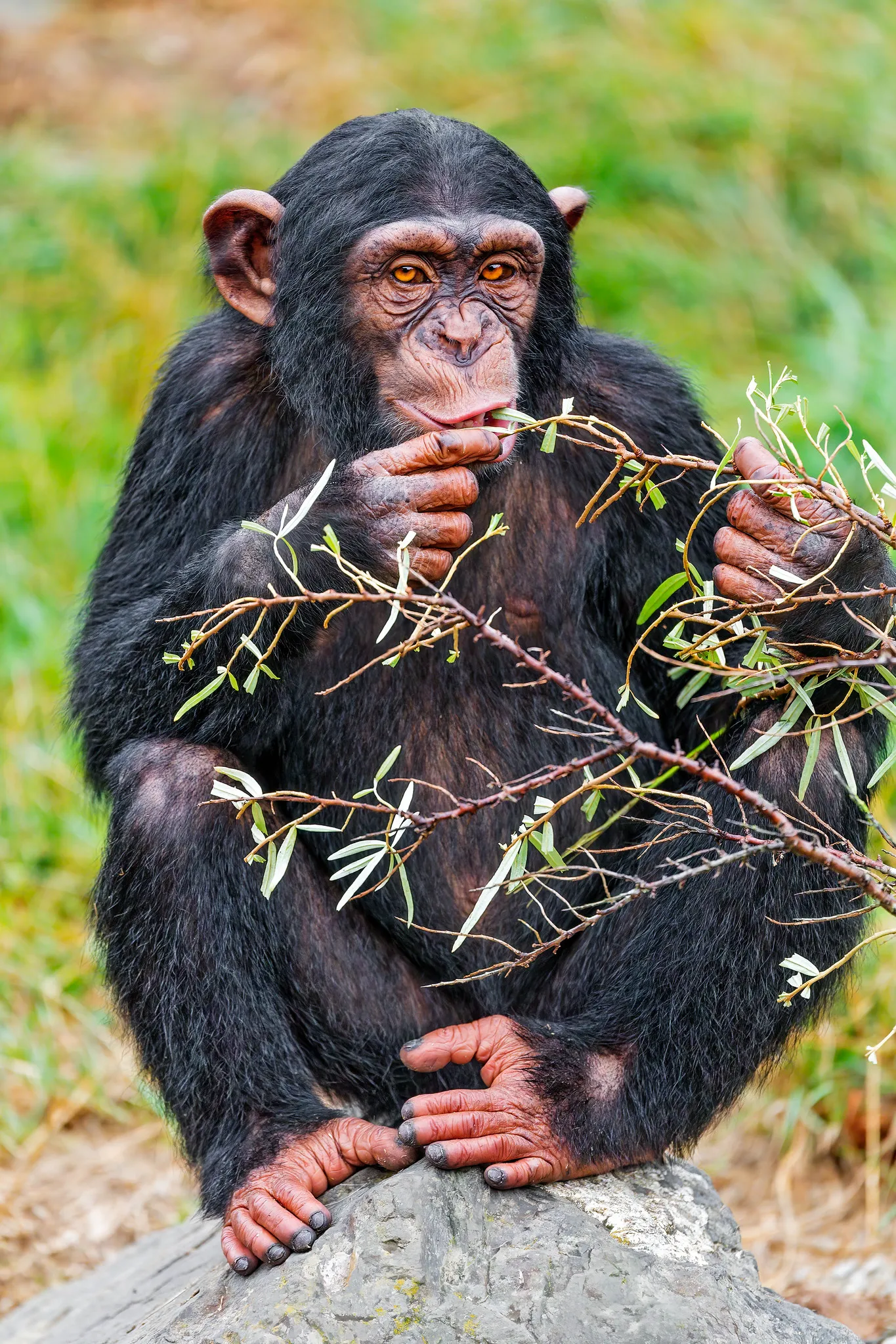
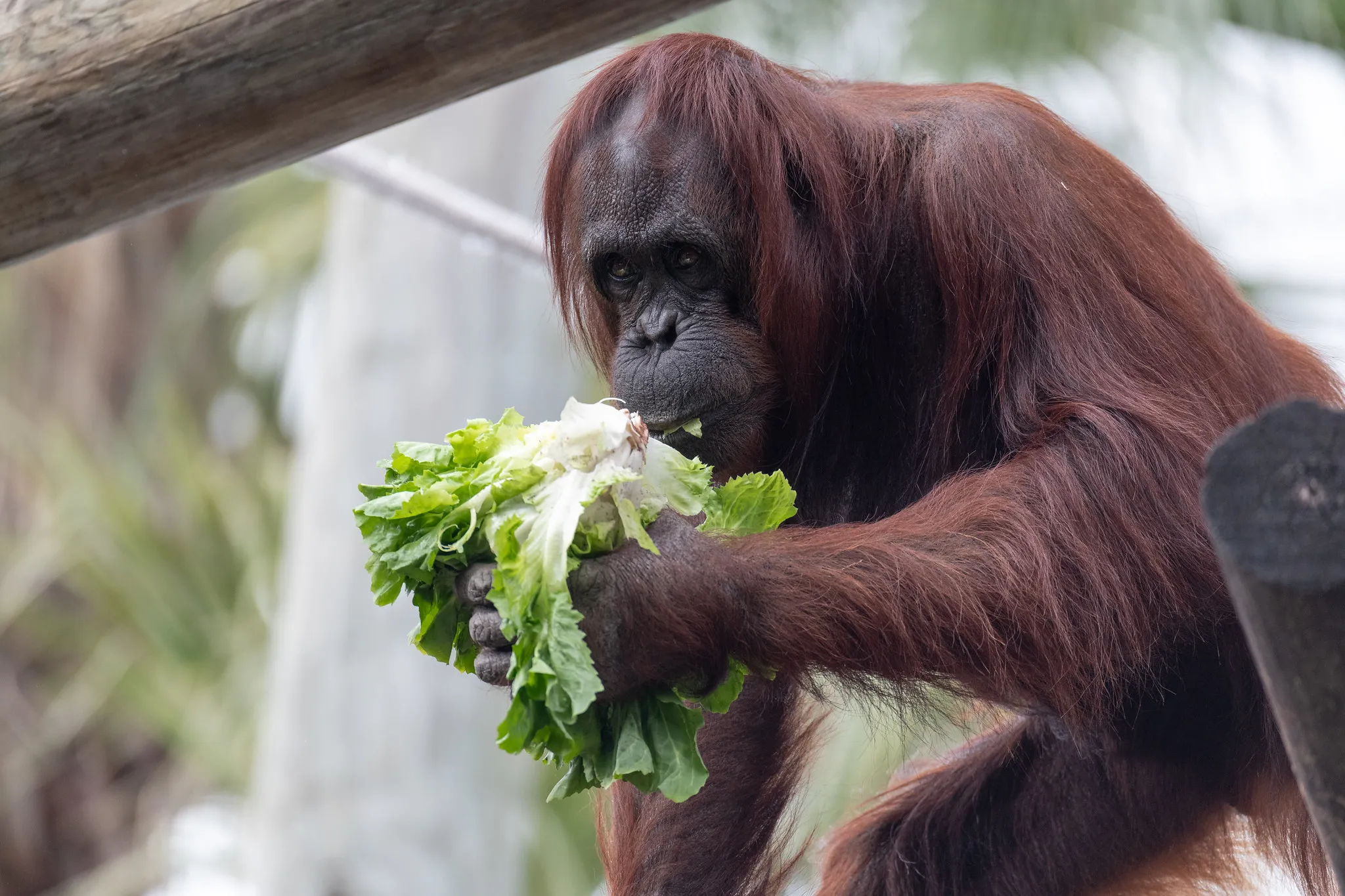
Chimpanzee:
Omnivores, with a diet consisting of fruits, leaves, insects, and occasionally meat through hunting.
Orangutan:
Primarily frugivores, with fruits comprising a significant portion of their diet.
Also consume leaves, bark, and insects.
Comparison:
While both species share an omnivorous diet, the proportions of different food types vary, with chimpanzees having a more diverse diet, including regular hunting.
Ecological Implications:
Varied feeding strategies contribute to their ecological roles and impact on local flora and fauna.
16. Intelligence:
Chimpanzee:
Highly intelligent, known for tool use and problem-solving.
Complex social structures with intricate communication.
Orangutan:
Intelligent, with remarkable problem-solving abilities.
Solitary nature influences a different form of cognitive adaptation.
Comparison:
Both species exhibit high intelligence, but chimpanzees are more socially inclined, while orangutans display individualistic cognitive adaptations.
Ecological Implications:
Intelligence plays a role in foraging strategies, tool use, and adaptation to their specific ecological challenges.
17. Social Behavior:
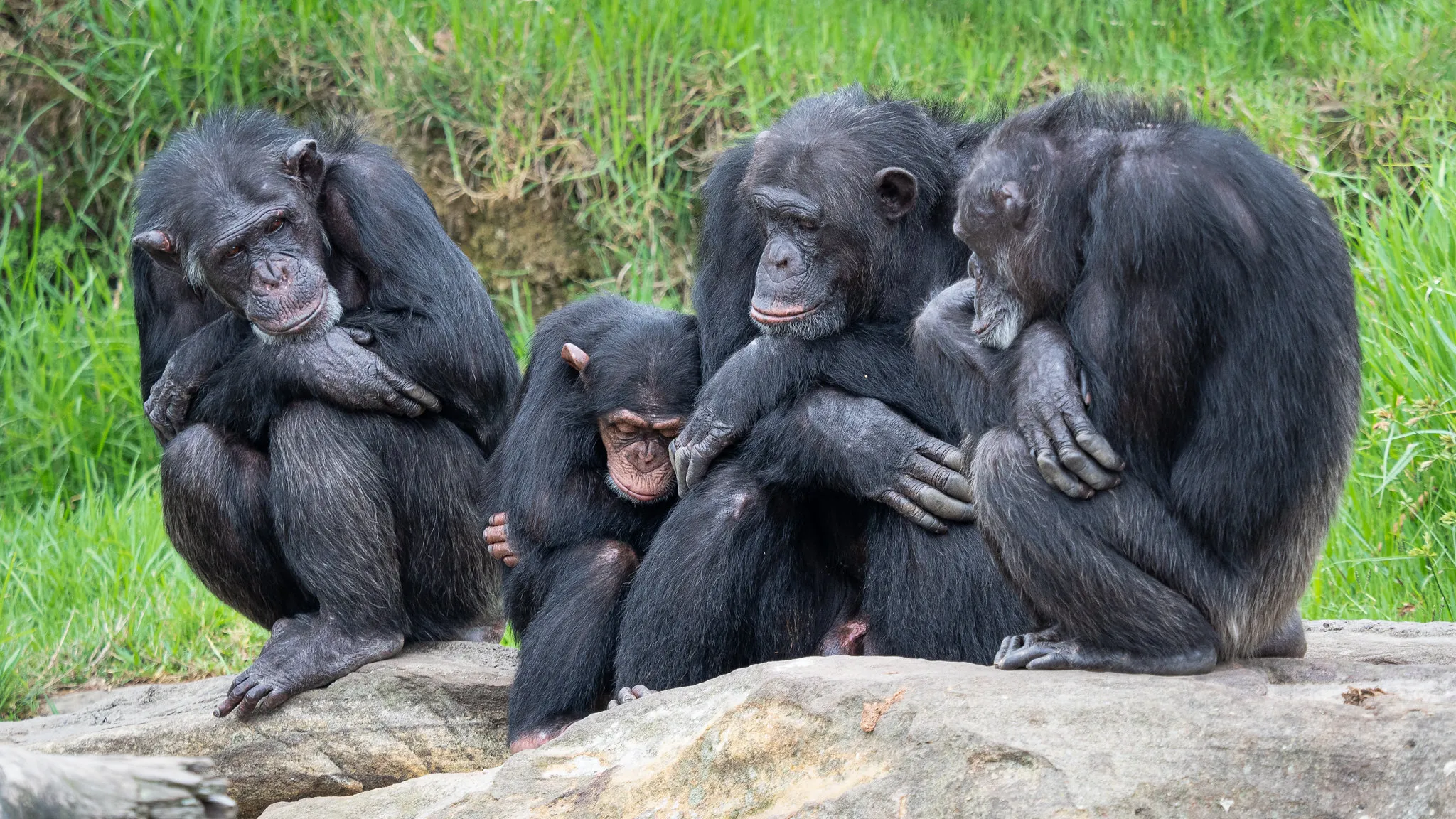
Chimpanzee:
Live in large, complex communities with intricate social hierarchies.
Form strong social bonds through grooming, playing, and sharing food.
Orangutan:
Generally solitary, with occasional interactions, especially during mating.
Dominant males establish territories and may have limited social interactions.
Comparison:
Chimpanzees are highly social, emphasizing group cooperation, while orangutans are more solitary, focusing on individual lifestyles.
Ecological Implications:
Social structures impact resource distribution, mating strategies, and overall adaptation to their specific ecological niches.
18. Mode of Reproduction:
Chimpanzee:
Polygamous mating system.
Females typically give birth every 5 to 6 years.
Orangutan:
Generally solitary, with mating occurring when females are in estrus.
Females have a longer inter-birth interval, usually around 8 years.
Comparison:
Chimpanzees exhibit a more frequent mating system with multiple partners, while orangutans have a less frequent and solitary approach.
Ecological Implications:
Reproductive strategies align with their social structures, impacting population dynamics and genetic diversity.
19. Parental Behavior:
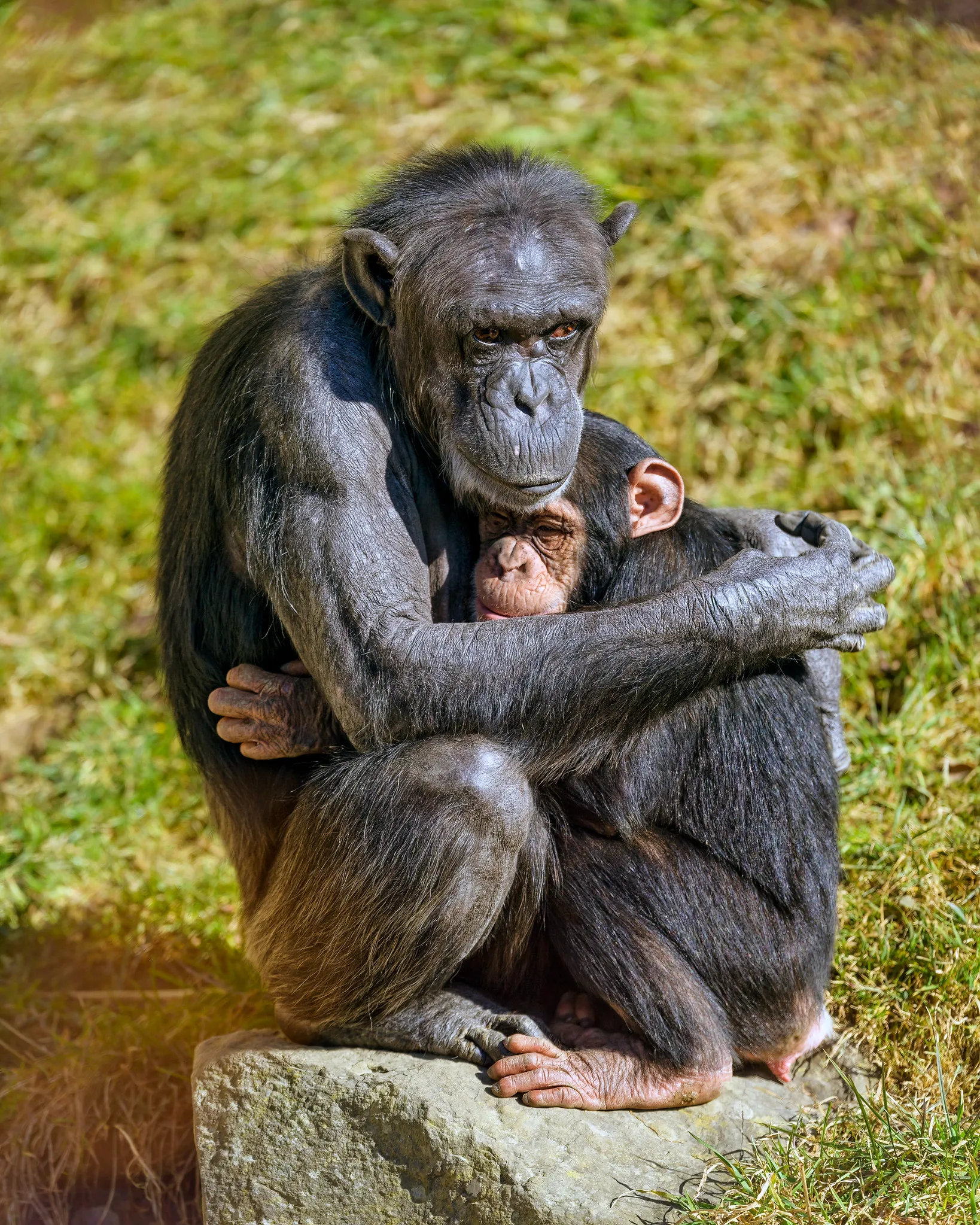
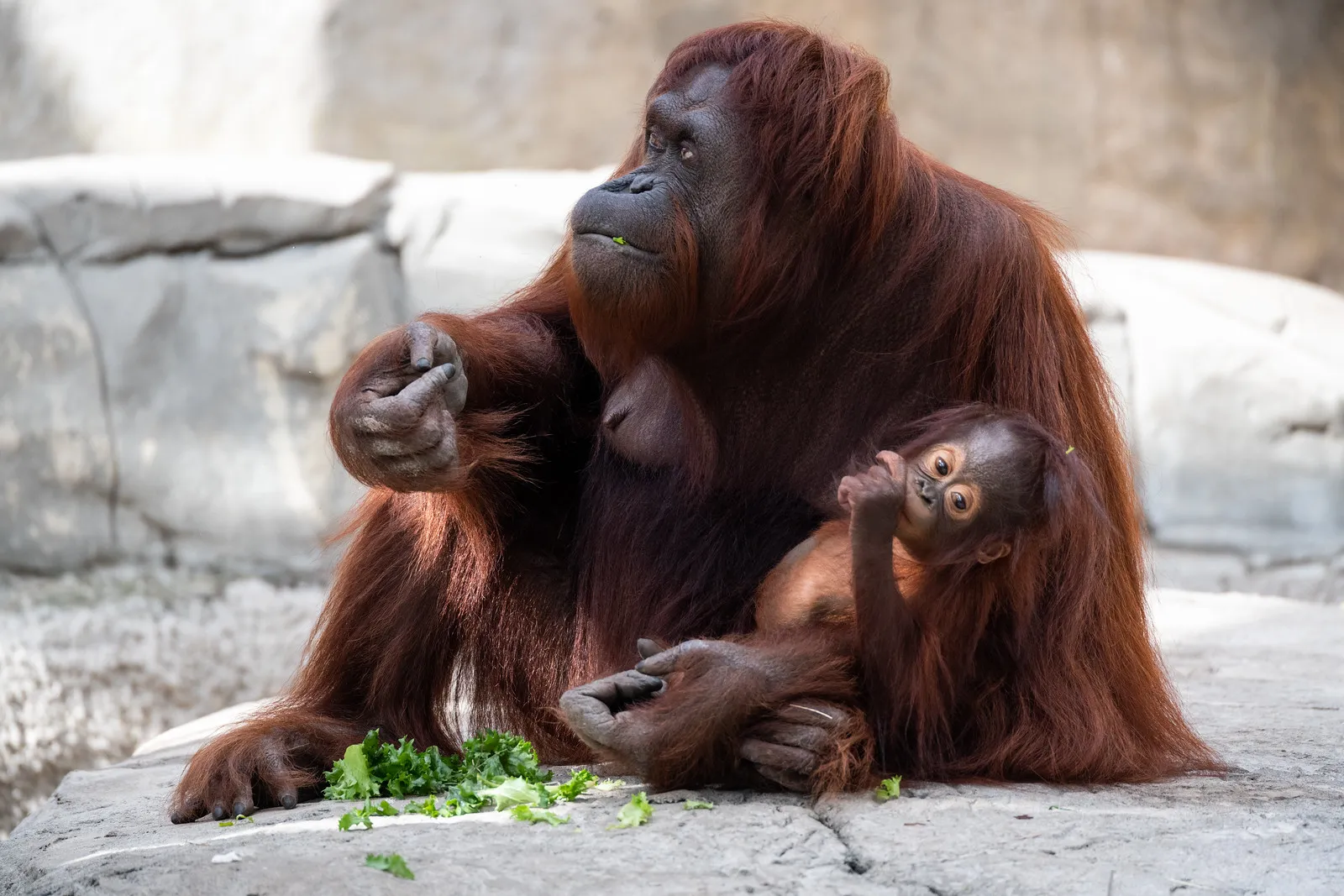
Chimpanzee:
Offspring stay with the mother for an extended period, learning social and survival skills.
Maternal care involves grooming and protection.
Orangutan:
Mothers provide substantial care, with offspring staying with the mother for a longer duration.
Limited social interaction with other adults during this period.
Comparison:
Both species exhibit strong maternal care, but orangutans have a more prolonged period of offspring dependence.
Ecological Implications:
Parental behaviors influence the survival and development of offspring, impacting population dynamics in their habitats.
20. Proximity to Human-Inhabited Areas:
Chimpanzee:
Face threats from habitat loss and fragmentation due to human activities.
Encounters with humans in some regions, leading to conflicts.
Orangutan:
Highly affected by deforestation and illegal pet trade.
Close proximity to human-inhabited areas increases the risk of conflicts.
Comparison:
Both species face threats from human activities, primarily habitat destruction and encroachment.
Ecological Implications:
Human proximity poses challenges such as increased risks of disease transmission, habitat loss, and direct conflicts, impacting their conservation status.
21. Behavior Toward Humans:

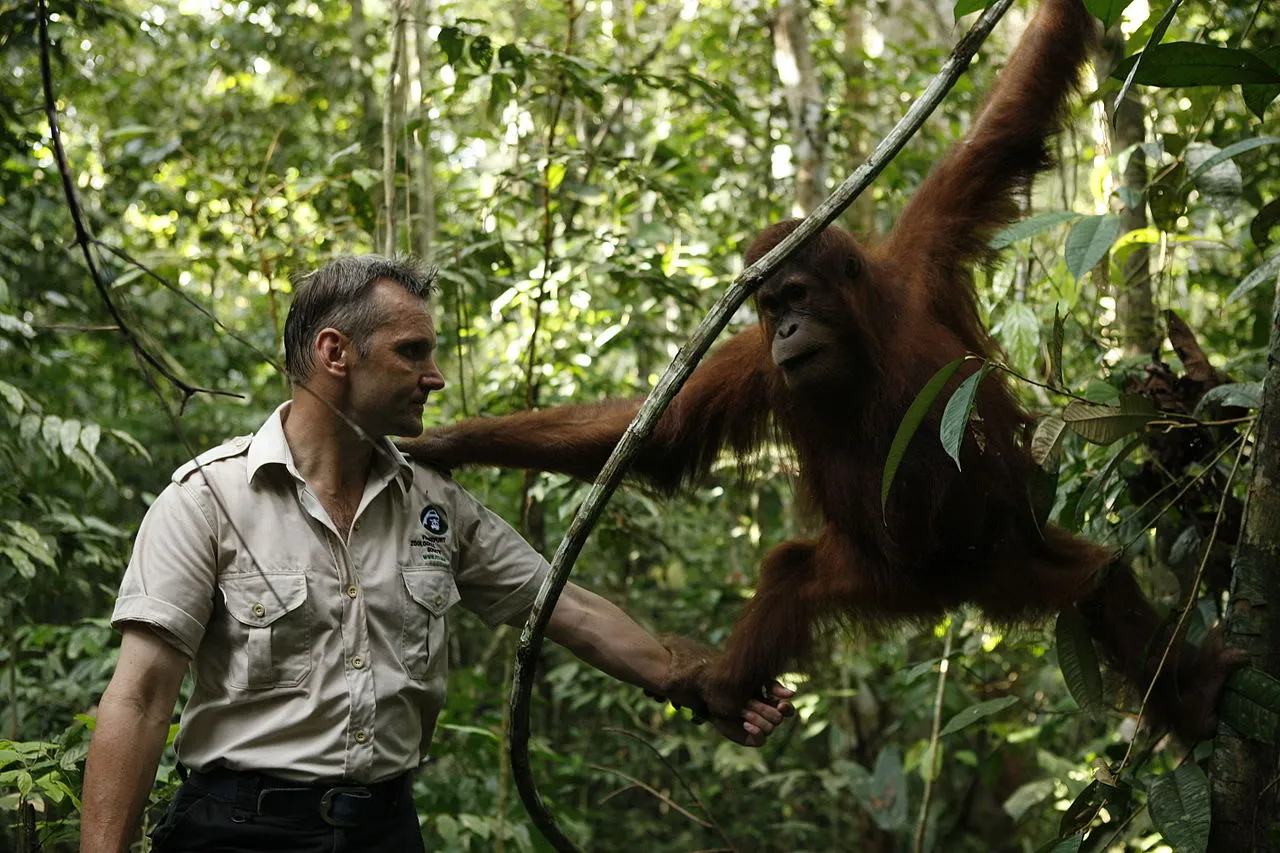
Chimpanzee:
Varied responses, ranging from curiosity to aggression.
Can be aggressive when feeling threatened or competing for resources.
Orangutan:
Generally shy and avoidant of humans.
May display aggression if cornered or provoked.
Comparison:
Chimpanzees may exhibit more diverse reactions, while orangutans typically avoid human contact.
Ecological Implications:
Behavioral responses to humans influence conservation efforts, with understanding these behaviors being crucial for effective protection and management.
22. Danger Posed to Humans:
Chimpanzee:
Can pose a threat, especially if they feel threatened or perceive humans as competitors.
Infamous cases of chimpanzee attacks on humans have been reported.
Orangutan:
Generally, pose minimal danger as they are more shy and avoidant of humans.
Rare instances of aggression may occur, especially if they feel cornered.
Comparison:
Chimpanzees have a higher potential for aggression towards humans compared to the more docile orangutans.
Ecological Implications:
Understanding potential dangers is crucial for conservation efforts and managing human-wildlife conflicts.
23. Associated Precautions:
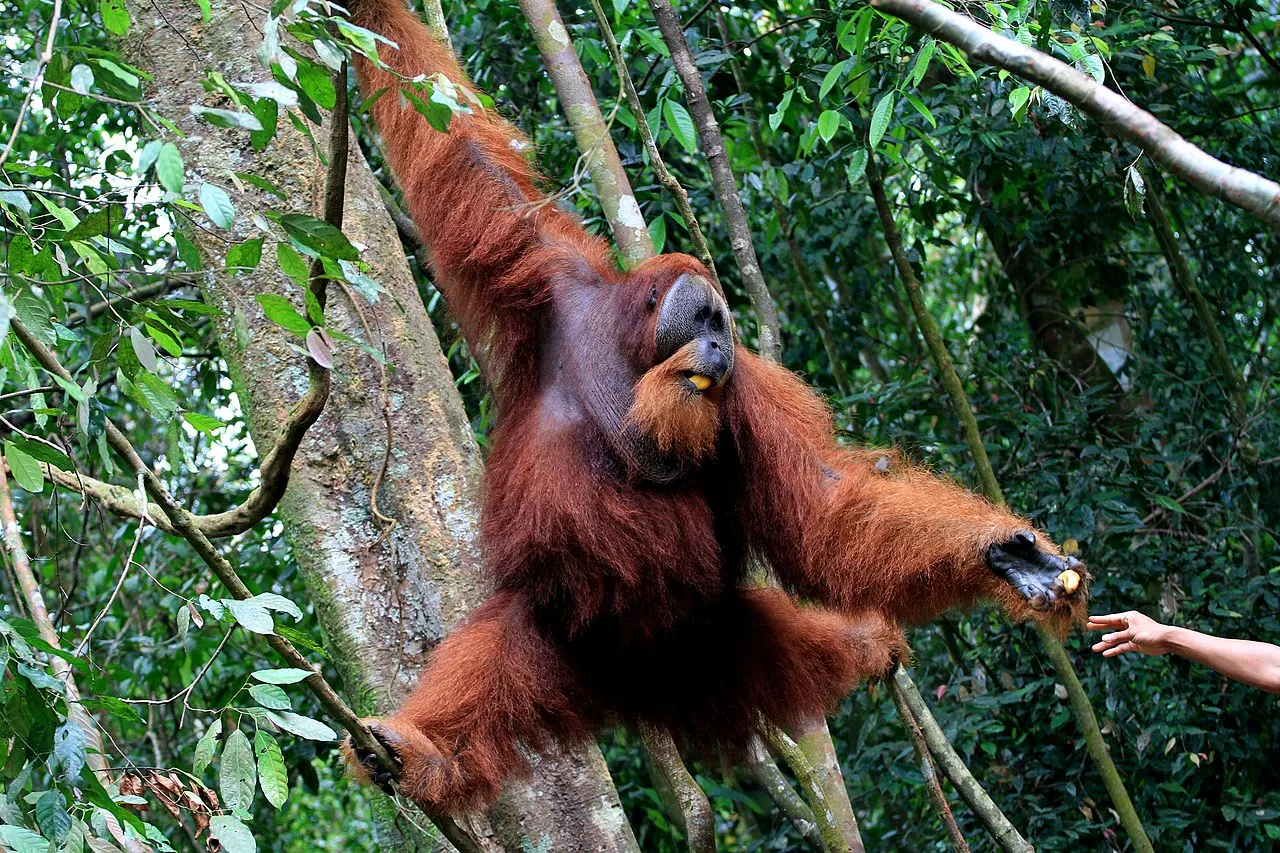
Chimpanzee:
Caution needed in regions where human and chimpanzee habitats overlap.
Implementation of guidelines for minimizing conflicts and ensuring human safety.
Orangutan:
Awareness programs to educate locals on avoiding interactions with orangutans.
Conservation measures focusing on habitat protection to reduce human-wildlife conflicts.
Comparison:
Precautions vary based on the species’ behavior, with chimpanzees requiring more caution.
Ecological Implications:
Implementation of precautions aims to mitigate potential conflicts, contributing to the coexistence of humans and these great apes in shared landscapes.
24. Conservation Status:
Chimpanzee:
Varies by subspecies; some are endangered, and others are vulnerable.
Threatened by habitat loss, hunting, and disease.
Orangutan:
Bornean orangutans are endangered, while Sumatran orangutans are critically endangered.
Main threats include habitat destruction and illegal pet trade.
Comparison:
Both species face severe conservation challenges, with orangutans generally having a more critical status.
Ecological Implications:
Conservation efforts are essential to preserve these species and maintain biodiversity in their respective habitats.
*Summary of Comparison
Appearance:
Chimpanzees: Robust build, black to brown fur, prominent ears, no tail.
Orangutans: Shaggy reddish-brown hair, large body, pronounced cheek pads in males.
Size:
Chimpanzees: Smaller, males 90-130 cm, females 70-100 cm.
Orangutans: Larger, males 120-180 cm, females 100-130 cm.
Weight:
Chimpanzees: Males 40-60 kg, females 27-50 kg.
Orangutans: Males 50-120 kg, females 30-50 kg.
Dentition and Bite Force (PSI):
Chimpanzees: Robust teeth, 1,000 psi bite force.
Orangutans: Long canines, 1,300 psi bite force.
Physical Offensive Advantages:
Chimpanzees: Cooperative attacks, tool use.
Orangutans: Intimidating presence, skilled climbers.
Physical Defensive Advantages:
Chimpanzees: Group defense, agile climbing.
Orangutans: Climbing skills, dominant males’ physical prowess.
Speed:
Chimpanzees: Around 40 km/h.
Orangutans: Not adapted for fast terrestrial locomotion.
Agility:
Chimpanzees: Agile in trees and on the ground.
Orangutans: Arboreal agility, less agile on the ground.
Senses:
Chimpanzees: Vision for depth perception, excellent hearing.
Orangutans: Reliant on acute vision, vocalizations for communication.
Overall Physical Capacity:
Chimpanzees: Agile, strong arms, tool use.
Orangutans: Powerful climbers, long arms, solitary nature.
Habitat Preference(s) and Geographic Region:
Chimpanzees: Various habitats in Central and West Africa.
Orangutans: Primarily tropical rainforests in Borneo and Sumatra.
Tracks:
Chimpanzees: Opposable thumbs, knuckle-walking tracks.
Orangutans: Long fingers and toes, heel-first walking pattern.
Lifespan:
Chimpanzees: 40-50 years.
Orangutans: Bornean 35-45 years, Sumatran 30-40 years.
Mode of Feeding:
Chimpanzees: Omnivores with diverse diet.
Orangutans: Primarily frugivores, fruits as a significant part.
Intelligence:
Chimpanzees: Highly intelligent, tool use, complex social structures.
Orangutans: Intelligent, problem-solving, individualistic cognitive adaptations.
Social Behavior:
Chimpanzees: Large, complex communities, strong social bonds.
Orangutans: Generally solitary, limited social interactions.
Mode of Reproduction:
Chimpanzees: Polygamous mating, shorter inter-birth interval.
Orangutans: Solitary mating, longer inter-birth interval.
Parental Behavior:
Chimpanzees: Offspring stay, maternal care involves grooming.
Orangutans: Prolonged maternal care, limited social interaction.
Proximity to Human-Inhabited Areas:
Both face threats from habitat loss, illegal activities, and human-wildlife conflicts.
Behavior Toward Humans:
Chimpanzees: Varied responses, potential aggression.
Orangutans: Generally shy, avoidant of humans.
Danger Posed to Humans:
Chimpanzees: Can be aggressive if threatened.
Orangutans: Generally pose minimal danger, shy and avoidant.
Associated Precautions:
Chimpanzees: Caution in overlapping habitats, guidelines for minimizing conflicts.
Orangutans: Awareness programs, conservation measures for habitat protection.
Conservation Status:
Chimpanzees: Varies by subspecies, endangered or vulnerable.
Orangutans: Bornean endangered, Sumatran critically endangered.
Conclusion
I). Similarities:
Both chimpanzees and orangutans belong to the family Hominidae and share common primate characteristics.
Face threats from habitat loss, human-wildlife conflicts, and illegal activities.
II). Differences:
Divergent social structures, with chimpanzees being more social and orangutans more solitary.
Varying ecological roles, reflected in their physical adaptations, feeding strategies, and reproductive behaviors.
Differences in conservation status, emphasizing the need for targeted conservation efforts tailored to each species’ unique challenges.
